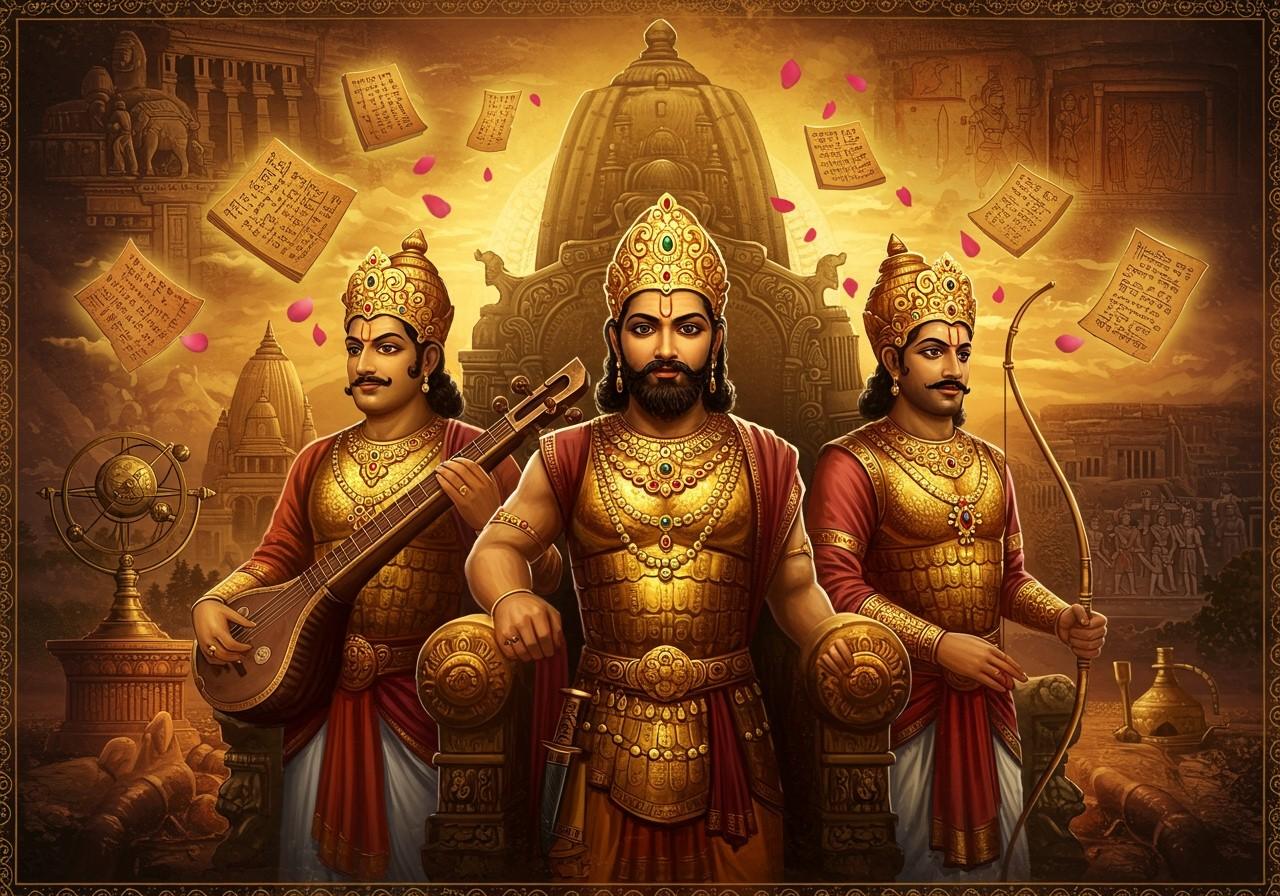
The Gupta Empire, a period spanning from the late 3rd century CE to 543 CE, is widely recognized as the Golden Age of India. Founded by Sri Gupta and significantly expanded by his grandson, Chandragupta I, the empire flourished under rulers like Chandragupta I, Samudragupta, and Chandragupta II. This era witnessed remarkable advancements in various fields, including architecture, sculpture, painting, arts, sciences, religion, and philosophy, solidifying its place as a pivotal period in Indian history. The accomplishments of these rulers are meticulously documented in historical texts such as the Allahabad Pillar writings and the Mehrauli Iron Pillar inscriptions.
Chandragupta I (c. 320-335 CE): The Foundation of an Empire
Chandragupta I laid the cornerstone of the Gupta Empire. His strategic marriage to Kumaradevi, a Licchavi princess, proved instrumental in consolidating power across Northern India. This alliance, combined with successful military campaigns, ushered in an era of economic prosperity, evidenced by the minting of gold coins. Chandragupta I’s reign established a strong foundation for the empire’s future growth and influence.
Samudragupta (c. 335-375 CE): The Napoleon of India
Samudragupta, often hailed as the “Napoleon of India,” significantly expanded the empire’s reach through ambitious military expeditions. His conquests stretched from the Himalayas to Southern India, solidifying his reputation as a formidable ruler. Beyond his military prowess, Samudragupta was a fervent patron of the arts, composing poetry and music. The Allahabad Pillar inscription serves as a testament to his victories and achievements, while his administrative reforms further strengthened the empire’s governance.
Chandragupta II (c. 375-415 CE): Vikramaditya and the Zenith of the Gupta Era
Chandragupta II, also known as Vikramaditya, further extended the empire’s boundaries by defeating the Saka rulers in Western India. His reign is synonymous with the peak of the Gupta Golden Age, marked by significant advancements in various fields. A patron of scholars like Kalidasa and Aryabhata, Chandragupta II fostered a thriving intellectual environment that led to groundbreaking discoveries in literature and science. Notable architectural marvels from his era include the iconic Iron Pillar of Delhi. Furthermore, his diplomatic initiatives with foreign kingdoms facilitated trade and cultural exchange, enriching the empire’s global standing.
Kumaragupta I (c. 415-455 CE): Maintaining Stability and Fostering Learning
Kumaragupta I played a crucial role in preserving the empire’s stability during his reign. He successfully defended the vast territories inherited from his predecessors and made significant contributions to education by founding Nalanda University, a renowned center of learning. His patronage extended to religious architecture, marked by the construction of numerous temples. The economic stability of his rule is reflected in the diverse range of coins minted during his time.
Skandagupta (c. 455-467 CE): Defender Against Invaders
Skandagupta faced the formidable challenge of repelling the Huna invaders, a threat that jeopardized the empire’s integrity. His successful defense preserved the empire and demonstrated his military acumen. Beyond military achievements, Skandagupta focused on infrastructure development, repairing dams and irrigation systems. His effective governance ensured economic stability despite the challenges posed by external threats.
Achievements of the Gupta Empire
The Gupta period witnessed remarkable progress across a spectrum of disciplines:
- Mathematics: The Gupta era saw the introduction of the concept of zero and the decimal system, revolutionary advancements that laid the foundation for modern mathematics. These innovations significantly impacted mathematical calculations and paved the way for future mathematical discoveries.
- Astronomy: Aryabhata’s groundbreaking work on the solar system revolutionized astronomical understanding. His calculations and theories provided new insights into the celestial bodies and their movements, leaving a lasting impact on the field of astronomy.
- Art and Architecture: The Gupta period witnessed the flourishing of classical Indian art and architecture. Magnificent examples include the Ajanta and Ellora caves, showcasing the artistic and architectural prowess of the era. These masterpieces reflect the sophisticated aesthetic sensibilities and engineering skills prevalent during the Gupta reign.
- Literature: Literature reached new heights during the Gupta era, with notable contributions from literary giants like Kalidasa, whose plays and poetry remain celebrated to this day. This period became a golden age for Sanskrit literature, with a proliferation of diverse literary forms and styles.
Honoring the Gupta Legacy with Poojn.in
Poojn.in, India’s leading online store for cultural and religious goods, offers a wide selection of products that connect you to the rich traditions of the Gupta era. Our curated collection supports your spiritual practices with authentic items reminiscent of this golden age:
- Temple Worship Items: Discover items similar to those used in Gupta-era temples, allowing you to experience the reverence and sanctity of ancient worship practices. Explore our collection of puja items.
- Metal Craftsmanship: Find pure copper and brass items that reflect the metallurgical excellence of the Gupta period, showcasing the artistry and craftsmanship of that era. Browse our brass and copper collection.
- Traditional Incense: Experience the aromatic traditions of the past with incense and dhoop made using ancient Ayurvedic formulas, transporting you to the sensory world of the Gupta era. Discover our range of traditional incense.
Visit www.poojn.in to explore our complete range of authentic puja items and experience the legacy of the Gupta Empire.
Legacy of the Gupta Dynasty
The Gupta rulers left an enduring legacy, shaping Indian history and culture in profound ways. Their reign was characterized by prosperity, innovation, and a flourishing of artistic and intellectual pursuits. The advancements in mathematics, astronomy, art, and literature during the Gupta Empire continue to inspire and influence modern India. This legacy serves as a reminder of our rich heritage and the importance of preserving and celebrating our history.
FAQs on the Gupta Empire
Who was known as the “Napoleon of India”? Samudragupta earned the title “Napoleon of India” due to his extensive military conquests and the expansion of the Gupta Empire.
Which ruler repelled the Huna invaders? Skandagupta successfully defended the Gupta Empire against the Huna invaders, safeguarding its stability and security.
Who was Vikramaditya? Chandragupta II was known as Vikramaditya, a ruler celebrated for his patronage of the arts and his successful reign.


